No. 17, Vol. 2. Autumnal Equinox 2009

Tarocchio as a Tool for Landscape Divination
by Frater L
As an introduction, I will indicate that I do not use "reversed" cards, and my usual deck since I obtained it in 1971 is the Thoth deck. I shuffle by cuts of three interleaved as in secular card games and then hold the pack for a while firmly in the palms as I reflect on the scope of the reading. As my cards are quite old, well dog-eared and comfortable, they feel "familiar" to the hand.
The subject of the reading will thus be, "the underlying forces of the natural regions of the British Isles". Now, firstly, what does one mean by "natural regions"? I would argue that these are more or less the areas which grew out of the post-Roman period in these islands, as the following map will make clear :

We have six greater units of five each ; their particular characteristics will emerge with the reading, but one image instantly springs to mind, the pentagram star of the four elements with the spirit or quintessence. We'll assign these functions after seeing the pentagram chart.
How are we to lay out the cards? My usual layout for a specific question is the Celtic Cross, and we could use that layout for each region ; but that would entail a treatise to do justice to the result. We could imagine a layout of three cards for each region, past, present, and future, arranged in the pentagrams of each greater grouping. The following pentagram chart already gives us some interesting hidden indications :
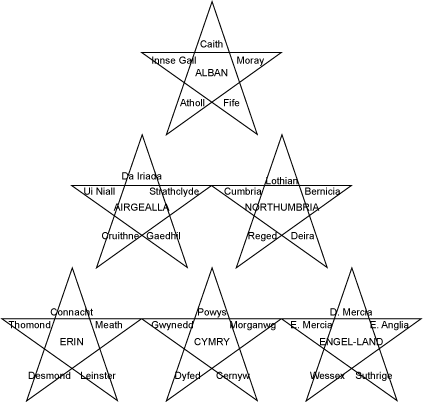
We shall now draw our readings ; some special circumstances we need to bear in mind first.
- Suthrige is the point of entry into the Great Triangle from continental Europe ;
- Caith is the point of entry into the Great Triangle from Scandia ;
- Desmond is the point of entry into the Great Triangle for what the Ocean brings or represents ;
- Three secondary entry points on each vertical side of the Great Triangle ;
- A four-square defense at the base of the Great Triangle blocking the access to the Celtic Sea
The Reading

The first card, the Significator, is placed in the centre of the cross. This card represents the prime energy made manifest.
ATU II. The High Priestess : a pure, exalted and gracious influence. Education, knowledge, wisdom, and esoteric teachings. The forces of nature at the source of her inspiration. Intuition, foresight, and spiritual revelation of the most mysterious and arcane sort.
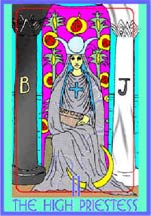
The Avatar of Albion.
She represents the deepest inspiration of the Land. In the Arthurian
Cycle she is the Lady of the Lake to whom the Sword is returned for
safe-keeping.
~0~
The second card, placed above the Significator, represents Air. It describes the spirit, the process of thought, and the influence of reason.
Queen of Pentacles : the essence of earth through water, such as a sacred spring: A warm and generous environment, providing shelter and comfort for all who would seek it. Steadfast, practical, and domestic, creating opulence and stability in any circumstances. Maturity and sensibility with an innate appreciation for nature and the material world.
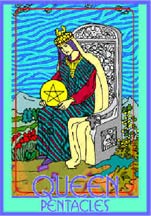
The Landscapes of Albion. The manifestation of the Avatar on the Landscape – a reflection of Atu III the Empress. A "Green and Pleasant Land". Here is Avalon, the "Land of Apples", reflected in Camelot.
~0~
The third card, placed to the right of the Significator, represents Fire. It describes motivations, creative energies, and the influence of passion.
Seven of Swords (Futility) : an opportunity to withdraw from a hopeless situation and fight another day. Disengagement from a struggle in which one should never have been involved. An attempt to resolve a matter without conflict. The use of cleverness or deception to turn the tide.
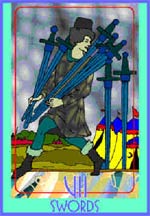
The Will of Albion. The theme of cyclic conflict leading to downfall. Mordred, and the Fight at Camlann.
~0~
The fourth card, placed below the significator, represents Water. It describes emotions, meditations, and the influence of love.
Three of Swords (Sorrow) : unsettling news leading to heartbreak or loneliness. Tactless or hurtful words. Acting without consideration for the emotions of others. Betrayal of trust or confidence. The revelation of a painful truth.
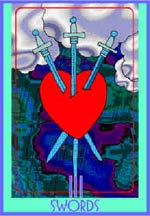
The Heart of Albion. "La Morte d'Artur". The Ship leaves for Avalon.
~0~
The fifth card, placed to the left of the Significator represents Earth. It describes physical presence, position in life, and the influence of the material world.
ATU XIII. Death : a major change or transformation, possibly traumatic and unexpected. Freedom from the shackles of the past, perhaps a reference to the Imperial form of manifestation. A new beginning : the return of the Regions. Death coupled with rebirth, usually related to consciousness and lifestyle.

The Forms of Albion. In the Arthurian Cycle, refers to the end of the Roman heritage – but prolonged, so it survives. The pre-Roman heritage resurfaces ; our map above appears.
~0~
ATU XI. Justice : the achievement of balance and inner harmony after a great trial. Agreements, contracts, or treaties concluded justly. Things set to rights. Karma restored. A turn for the better in legal matters.

The Way of Albion. The Lady of
the Lake now brandishes the Sword ; she awaits the next Arthur, as the
first Avatar accomplished his task.
~0~
The seventh card, placed on the bottom right of the triangle represents the force that opposes the bottom left card. These forces may be external, but they are frequently inner archetypes in conflict.
King of Wands : the essence of fire behaving as air, such as lightning. A great and daring leader who inspires others to rise to challenges alongside him. An artist who can take hold of an idea and make it a reality through bold action, one is immediately put in mind of Elisabeth I, in the days of direct sovereignty, and then chief ministers such as Peel, Palmerston or Churchill. One who is forceful, charismatic, and honest, leading by example, but unafraid to invest authority in others. A dashing and magnetic personality, carrying authority naturally, and striking at the world with swiftness and grace, thereby assuring success.
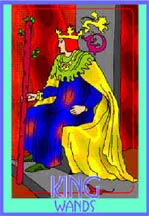
The Kings of Albion. Here is the next Arthur. Who knows where he will arise.
~0~
Three of Pentacles (Works) : the commencement of business, commercial transactions, or employment. The constructive use of creative talents, and the expression of artistry in workmanship. Skill and labour turned to the crafting of things of value. Using the conventional as a medium for expressing the exceptional, in order to build something of great renown and glory.
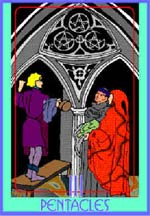
The Art of Albion. The accumulated Experience of the Cycle. Works such as cathedrals, craft masonry, and their translation into esoteric work.
~0~
The ninth and final card, placed in the centre bottom of the triangle, represents the final outcome unless there is a change of course.
ATU XVIII. The Moon : cyclic transformation covering the mysterious forces of the night. Feminine beauty and the intoxicating vitality of youth. The metamorphosis from beauty to beast and vice versa. Occult forces, sensitivities and intense dreams. Dangerous situations and perilous times.

The Goal of Albion. From the
Priestess to the Moon, from the Lady of the Lake to ..... the present
situation. Devolution, autonomy, but a creeping authoritarianism....
~0~
Notes
[1] Images used with permission. See http://www.m31.de/colman-smith/index.html and http://www.gnu.org/copyleft/fdl.html.